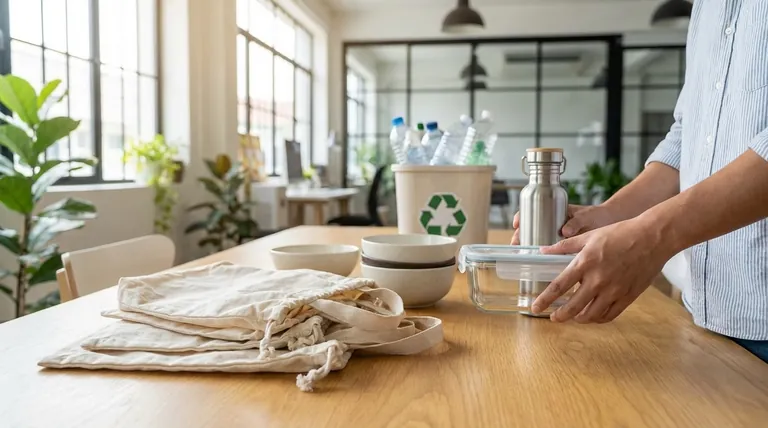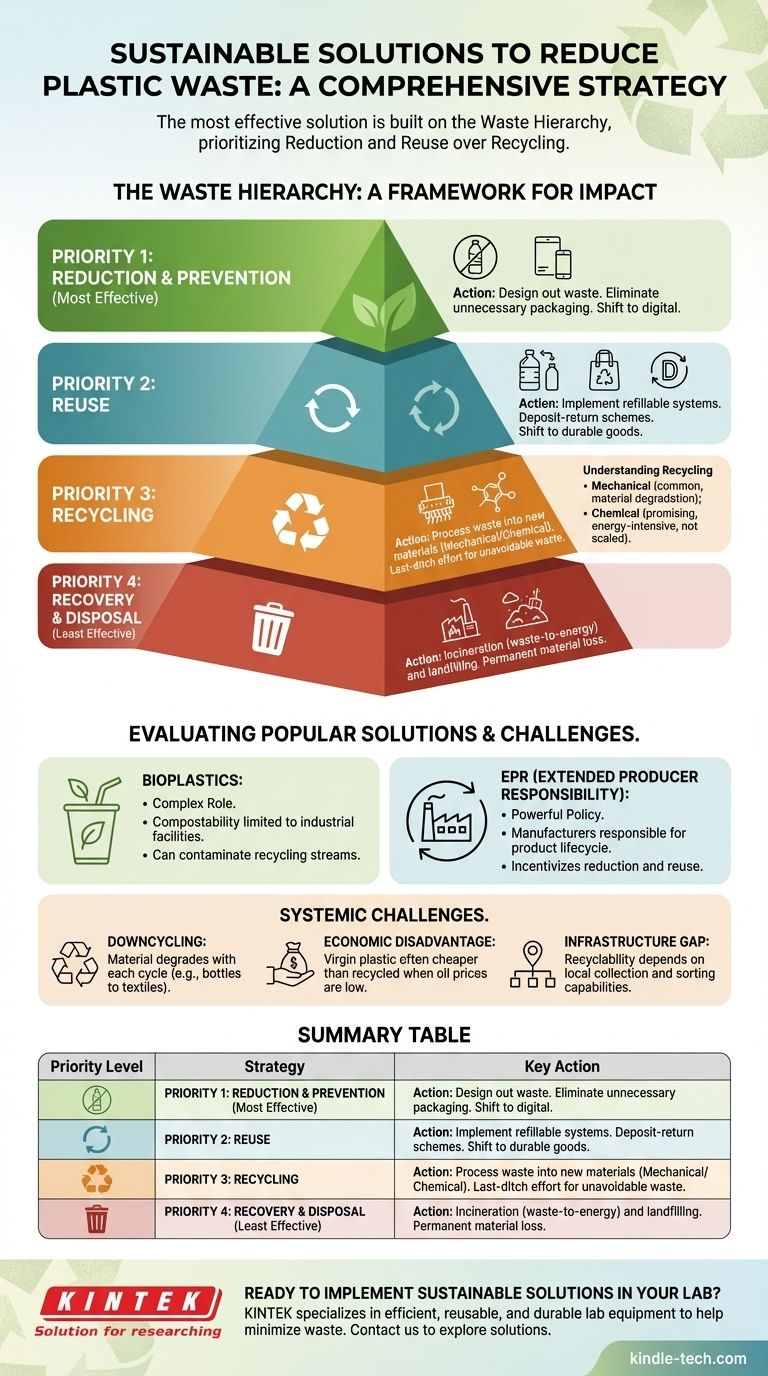Aunque ninguna tecnología por sí sola ofrece una solución mágica, la solución más eficaz y sostenible para reducir los residuos plásticos es una estrategia integral basada en la Jerarquía de Residuos. Este marco prioriza las acciones en orden de impacto ambiental, poniendo el mayor énfasis en la Reducción y la Reutilización mucho antes de considerar el reciclaje. Este enfoque aborda el problema en su origen, en lugar de solo gestionar los síntomas.
El error crítico es centrarse en el reciclaje como la solución principal. La verdadera sostenibilidad se logra repensando fundamentalmente el diseño, el consumo y las políticas para eliminar la necesidad de plásticos de un solo uso desde el principio.

La base: comprendiendo la jerarquía de residuos
La Jerarquía de Residuos es un marco universalmente aceptado que guía la gestión sostenible de los residuos. Clasifica las opciones de gestión de residuos de la más a la menos preferible, forzando un cambio de enfoque de los problemas posteriores (como el reciclaje) a las soluciones anteriores (como la prevención).
Prioridad 1: Reducción y Prevención
Este es el paso más impactante. El plástico más sostenible es el que nunca se crea.
La reducción implica diseñar sistemas y productos que requieran menos material o ningún plástico en absoluto. Esto incluye eliminar envases innecesarios, "aligerar" productos esenciales y cambiar a alternativas digitales.
Prioridad 2: Reutilización
Si el plástico no se puede eliminar, la siguiente mejor opción es mantenerlo en uso el mayor tiempo posible en su forma original.
Los sistemas de reutilización, como los envases rellenables para bebidas y productos de limpieza o los sistemas de depósito y devolución, preservan el valor del material y reducen significativamente la energía y los recursos necesarios para crear nuevos artículos. Representa un cambio de una mentalidad de usar y tirar a una de durabilidad.
Prioridad 3: Reciclaje
El reciclaje es el proceso de recuperar chatarra o residuos plásticos y reprocesarlos en nuevos productos. Es una parte crucial de la solución, pero es la tercera mejor opción por una razón.
Aunque desvía material de los vertederos, el proceso tiene limitaciones significativas, incluido el consumo de energía, la degradación del material y los problemas de contaminación. Debe verse como un último recurso para los artículos que no se pueden eliminar o reutilizar.
El último recurso: Recuperación y eliminación
Este nivel incluye procesos como la incineración para la obtención de energía a partir de residuos y, lo menos deseable, el vertido. Estas opciones se reservan para los residuos que no se pueden prevenir, reutilizar o reciclar y dan como resultado la pérdida permanente de recursos materiales.
Evaluación de "soluciones" populares a través de esta lente
Muchas soluciones propuestas reciben atención mediática, pero su verdadera sostenibilidad puede evaluarse utilizando la Jerarquía de Residuos.
El papel de los bioplásticos
Los bioplásticos a menudo se presentan como una solución simple, pero su papel es complejo. Algunos están diseñados para ser compostables, pero solo en instalaciones industriales, no en un contenedor de jardín o en el medio ambiente abierto.
Además, su producción puede tener su propia huella ambiental relacionada con el uso de la tierra y el agua. Si entran en las corrientes de reciclaje de plástico convencionales, actúan como contaminantes, lo que podría arruinar lotes enteros de material reciclable.
El poder de la Responsabilidad Extendida del Productor (REP)
La REP es un enfoque de política que hace a los fabricantes responsables de todo el ciclo de vida de sus productos, incluida su recolección y eliminación final.
Esta es una palanca poderosa para la Reducción y la Reutilización. Cuando las empresas asumen el costo financiero de sus residuos de envases, se les incentiva directamente a diseñar productos más ligeros, más fáciles de reutilizar y más eficientemente reciclados.
Reciclaje químico vs. mecánico
El reciclaje mecánico, el tipo más común, implica triturar, lavar, fundir y reformar el plástico. El reciclaje químico (o "reciclaje avanzado") utiliza varios procesos para descomponer los plásticos en sus bloques de construcción moleculares originales, que luego pueden usarse para crear nuevos plásticos de calidad virgen.
Si bien el reciclaje químico es prometedor para el manejo de plásticos mezclados difíciles de reciclar, actualmente consume mucha energía, a menudo tiene bajos rendimientos y aún no está probado a gran escala y económicamente viable.
Comprender las compensaciones y los desafíos sistémicos
Lograr una economía circular para los plásticos requiere reconocer los importantes obstáculos que existen dentro del sistema actual.
El mito de la reciclabilidad infinita
La mayoría de los plásticos comunes no se pueden reciclar sin fin. El proceso de fundir y reformar el plástico degrada las cadenas de polímeros, un fenómeno conocido como infrarreciclaje.
Después de unos pocos ciclos, el material pierde su integridad estructural y debe usarse para productos de menor calidad (por ejemplo, las botellas de plástico se convierten en textiles o madera) hasta que finalmente se vierte o incinera.
La desventaja económica
El plástico reciclado debe competir con el plástico virgen, que se produce directamente a partir de combustibles fósiles. Cuando los precios del petróleo son bajos, el plástico virgen suele ser más barato y de mayor calidad que su contraparte reciclada, lo que crea un escaso incentivo económico para que los fabricantes utilicen contenido reciclado.
La brecha de infraestructura
La reciclabilidad de un producto no tiene sentido sin la infraestructura local para recolectarlo, clasificarlo y procesarlo. La disponibilidad y capacidad de las instalaciones de reciclaje varían drásticamente entre municipios y países, lo que genera una confusión generalizada entre los consumidores y bajas tasas de reciclaje reales.
Tomar la decisión correcta para su objetivo
Para contribuir eficazmente a la solución, sus acciones deben alinearse con la Jerarquía de Residuos.
- Si usted es un diseñador de productos o un líder empresarial: Su enfoque principal debe ser diseñar para eliminar los residuos desde el principio, explorando materiales sin plástico e invirtiendo en sistemas robustos de reutilización y recarga.
- Si usted es un legislador: Priorice leyes como la Responsabilidad Extendida del Productor (REP) y proporcione financiación para la infraestructura de reutilización, lo que crea incentivos ascendentes para reducir los residuos.
- Si usted es un consumidor individual: Su mayor poder reside en reducir el consumo de artículos de un solo uso y elegir activamente alternativas reutilizables, haciendo del reciclaje su última opción, no la primera.
Un futuro sostenible para los plásticos no se logra gestionando mejor los residuos, sino creando un sistema económico y social que no los produzca en primer lugar.
Tabla resumen:
| Nivel de prioridad | Estrategia | Acción clave |
|---|---|---|
| 1 (Más eficaz) | Reducción y Prevención | Diseñar para eliminar residuos, eliminar envases innecesarios |
| 2 | Reutilización | Implementar sistemas rellenables, sistemas de depósito y devolución |
| 3 | Reciclaje | Procesar residuos en nuevos materiales (mecánico/químico) |
| 4 (Menos eficaz) | Recuperación y Eliminación | Incineración, vertido como último recurso |
¿Listo para implementar soluciones sostenibles en su laboratorio? KINTEK se especializa en equipos y consumibles de laboratorio, ayudando a los laboratorios a minimizar los residuos a través de productos eficientes, reutilizables y duraderos. Permítanos apoyar sus objetivos de sostenibilidad: contacte hoy mismo a nuestros expertos para explorar cómo nuestras soluciones pueden reducir su impacto ambiental manteniendo un alto rendimiento.
Guía Visual

Productos relacionados
- Película de embalaje flexible de aluminio y plástico para embalaje de baterías de litio
- Fabricante de piezas de teflón mecanizadas y moldeadas a medida para la limpieza de vidrio conductor ITO FTO de laboratorio, cesta de flores
- Horno Rotatorio Eléctrico Pequeño Horno Rotatorio Planta de Pirólisis de Biomasa
- Fabricante de piezas personalizadas de PTFE Teflon para bastidores de limpieza
- Unidad de destilación de agua montada en la pared
La gente también pregunta
- ¿Cuál es el propósito del laminado? Proteja y mejore sus documentos para un uso a largo plazo
- ¿Cuáles son las aplicaciones de los semiconductores de película delgada? Desde microchips hasta energía solar
- ¿Qué es la técnica de extrusión soplado de película? Una guía para la producción de películas plásticas de alta resistencia
- ¿Cuál es el recubrimiento más delgado? Desbloqueando propiedades únicas a escala atómica
- ¿Qué significa una película por capas? Desentrañando las profundidades de la narrativa cinematográfica







